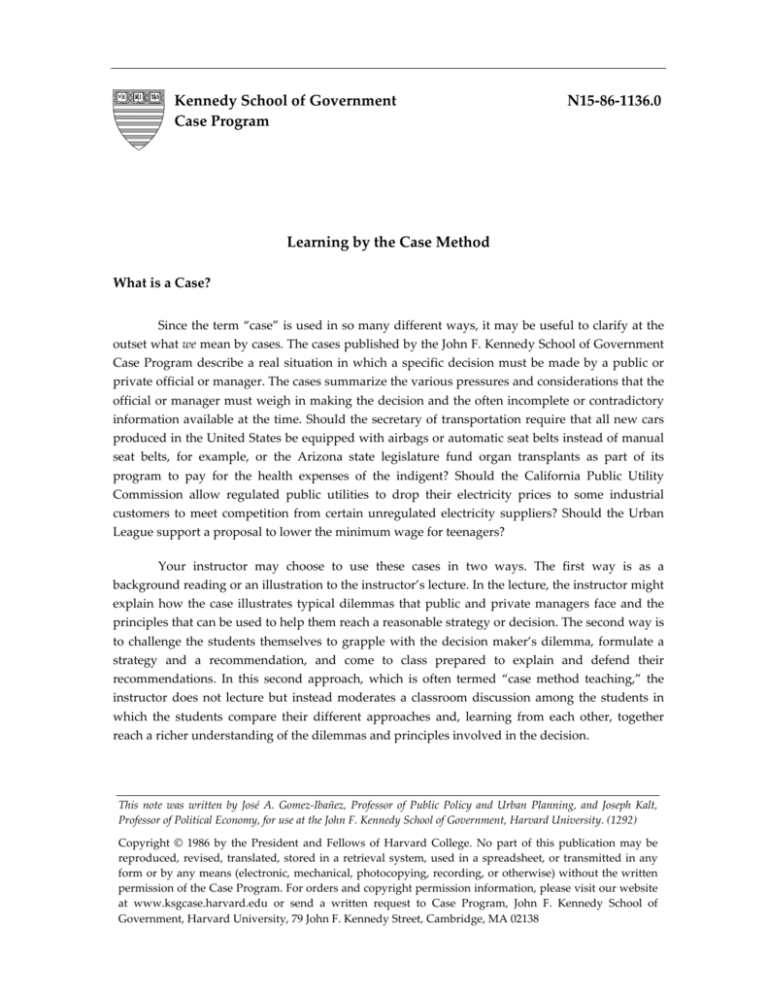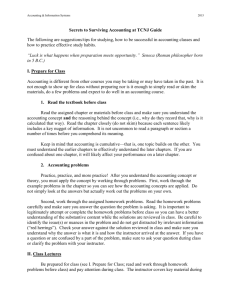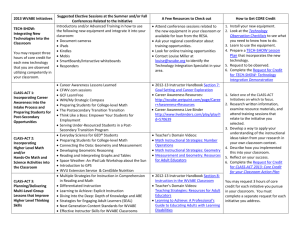Learning by the Case Method - HKS Case Program
advertisement

Kennedy School of Government Case Program N15-86-1136.0 Learning by the Case Method What is a Case? Since the term “case” is used in so many different ways, it may be useful to clarify at the outset what we mean by cases. The cases published by the John F. Kennedy School of Government Case Program describe a real situation in which a specific decision must be made by a public or private official or manager. The cases summarize the various pressures and considerations that the official or manager must weigh in making the decision and the often incomplete or contradictory information available at the time. Should the secretary of transportation require that all new cars produced in the United States be equipped with airbags or automatic seat belts instead of manual seat belts, for example, or the Arizona state legislature fund organ transplants as part of its program to pay for the health expenses of the indigent? Should the California Public Utility Commission allow regulated public utilities to drop their electricity prices to some industrial customers to meet competition from certain unregulated electricity suppliers? Should the Urban League support a proposal to lower the minimum wage for teenagers? Your instructor may choose to use these cases in two ways. The first way is as a background reading or an illustration to the instructor’s lecture. In the lecture, the instructor might explain how the case illustrates typical dilemmas that public and private managers face and the principles that can be used to help them reach a reasonable strategy or decision. The second way is to challenge the students themselves to grapple with the decision maker’s dilemma, formulate a strategy and a recommendation, and come to class prepared to explain and defend their recommendations. In this second approach, which is often termed “case method teaching,” the instructor does not lecture but instead moderates a classroom discussion among the students in which the students compare their different approaches and, learning from each other, together reach a richer understanding of the dilemmas and principles involved in the decision. This note was written by José A. Gomez-Ibañez, Professor of Public Policy and Urban Planning, and Joseph Kalt, Professor of Political Economy, for use at the John F. Kennedy School of Government, Harvard University. (1292) Copyright © 1986 by the President and Fellows of Harvard College. No part of this publication may be reproduced, revised, translated, stored in a retrieval system, used in a spreadsheet, or transmitted in any form or by any means (electronic, mechanical, photocopying, recording, or otherwise) without the written permission of the Case Program. For orders and copyright permission information, please visit our website at www.ksgcase.harvard.edu or send a written request to Case Program, John F. Kennedy School of Government, Harvard University, 79 John F. Kennedy Street, Cambridge, MA 02138 Learning by the Case Method__________________________________________________ N15-86-1136.0 Cases require more preparation and work on the part of the student than the usual reading assignment, particularly if they are used as the basis for a case method discussion rather than for a lecture. For a student to get the most out of a case and for the discussion (or even a lecture) to be fruitful, the student must immerse himself or herself in the case and attempt to formulate his or her own position and strategy before class and participate actively in the class discussion. Most students find this process both intellectually interesting and frustrating, especially because the most stimulating cases are ones in which reasonable people might—and, invariably, do—disagree about the appropriate course of action: either because of conflicting principles or considerations are involved or because the evidence is inconclusive. To justify and mitigate these extra burdens, we offer here a rationale for the case method and some pointers on how to prepare a case and participate in case discussions. Why Use Cases? Why is it worth the effort for you to struggle before class to understand the case to the point where you can formulate and defend your own course of action? Wouldn’t it be simpler and more efficient if the instructor just told you what the “answer” to the case was, since the instructor has more experience and has thought hard about the case already? The fundamental principles behind the case method are that the best learned lessons are the ones that you teach yourself, through your own struggles, and that many of the most useful kinds of understanding and judgment can not be told but must be learned through practical experience. When the instructors assign problem sets or papers in a course, they are motivated by a similar concern: by working through the problem set on your own or writing the paper, you reach a deeper understanding of the concepts and ideas than you would if you only read the text or listened passively to lectures. Case method teaching extends this principle to make preparing for class—and the class session itself—an active learning experience for you. And by using complex real world problems as the focus, it challenges you to learn skills that will be appropriate to the practical problems you will face as a public official, private manager, or responsible citizen. Preparing the Case How much you will get out of a case discussion depends greatly on how much effort you put into preparing it before class. Most students unaccustomed to cases are initially overwhelmed by the prospect of preparing one. That task can be imposing, since a variety of factors come into play and the facts are sometimes confusing or unclear. Fear not, however. Preparing a case involves slightly different skills than you may be accustomed to using in a typical classroom reading or homework assignment, but with a little application and practice you’ll find it manageable. 2 Learning by the Case Method__________________________________________________ N15-86-1136.0 Reading the Case. Perhaps the most common mistake is to think that you can prepare by reading the case through once and then thinking about it. Most cases require at least two readings, often more, to help you formulate an understanding of the problem and a well-reasoned course of action. In your first reading, try to familiarize yourself with the basic situation in the case. Your instructor may furnish discussion questions to help focus your attention on particular aspects of the case, and you should read these discussion questions before you read the case. Whether you have discussion questions, however, you should develop a basic checklist of questions to keep in mind during this first reading, such as: • Who is the decision maker in this case, and what specific decision does he or she have to make? • What are the objectives of the decision maker? • Who are the other important actors in the case and what are their objectives? • What are the key issues in dispute in the case? How do they bear on the discussion? • What is the environment in which the decision maker operates, and what specific constraints or opportunities does that environment establish? For example, what is the product or service produced, what is the relevant market, who are the competitors or regulators? Does the decision maker face constraints of money, time, institutional authority or other resources? • What are the possible courses of action for the decision maker? • What are the likely consequences of each course of action? What assumptions or arguments about the nature of the problem or the environment does one have to believe to make each course of action seem reasonable or likely to be successful? How plausible are those assumptions or arguments? How might other actors react? After the first reading, attempt to formulate one or, better still, several plausible courses of action, and then reread the case searching for evidence that supports or undercuts the various courses of action you are considering. Keep on reformulating your understanding of the problem and rereading the case to test that understanding until you feel comfortable with your position. Above all, try to immerse yourself in the case when reading and thinking about it. Try to imagine yourself as the decision maker and take his or her problem to heart. What should you, the decision maker, do? What do you need to know to decide? What will be the consequences if you are wrong? 3 Learning by the Case Method__________________________________________________ N15-86-1136.0 Using Evidence and Numbers. One of the most difficult problems in preparing a case is sorting through the mass of information and evidence. Usually, the case provides considerable background information on the firm, agency, or market involved, of varying relevance to the decision at hand. Often the case describes a dispute between several actors, each championing a different course of action and advancing evidence to support their claims. Important skills in preparing a case, as in real life, are deciding what information is important and evaluating apparently conflicting evidence. One of the basic reasons for reading a case at least twice is to help avoid being overwhelmed and paralyzed by all the available information. It is difficult to identify and evaluate the key evidence on a first reading. After you have familiarized yourself with the basic facts of the case and formulated a few hypotheses about the nature of the problem and the most plausible courses of action, ask yourself what evidence would be needed to support (or oppose) those courses of action and reread the case looking for that evidence. If you decide that a key issue in the decision is whether the market is competitive, for example, then reread the case with an eye for evidence that there are structural barriers to competition or that the firms are able to maintain prices above their costs. You should be slightly skeptical about the information presented or the interpretation placed on it by various actors in the case. Does the evidence an actor cites really support his or her argument persuasively, for example, or are there alternative interpretations that one could draw from that data? Obviously, you won’t have the time to question every bit of evidence presented in a case. If the evidence appears critical to the debate or decision, however, ask yourself what it really implies and whether it is as compelling as it seems. It is often helpful to use numbers and make calculations to test and develop your arguments. Numbers can help you decide whether a particular problem is important or unimportant. If economies of scale may be a barrier to competition, for example, how large are fixed costs relative to variable costs? Simple calculations may also help resolve key issues in the case. If a critical question is the profitability of a product, for example, you may want to make a few calculations of likely costs, revenues, or profits. As in real life, you may be faced with many numbers but unable to find exactly the ones you think you need. As with other forms of evidence, you can avoid getting lost in the numbers by formulating your hypotheses first before you begin a detailed search through the tables or turn on your calculator. If you can’t find the particular numbers you think you need, don’t be afraid to try to make approximations from the numbers you have. If you aren’t given the marginal cost of a product or service, for example, maybe you can find or calculate a close proxy. Be mindful of the limitations of your approximations, of course, such as whether they are likely to overestimate or underestimate the true figures. 4 Learning by the Case Method__________________________________________________ N15-86-1136.0 It is especially easy to get confused when making calculations. A few simple rules will help you avoid getting diverted and overwhelmed by a mass of numbers that you create:1 • Always ask why you are calculating a number before you begin. • If a calculation is complex, break it down into components and write them down as you go. • Keep track of the units of measurement you are using at each step (e.g., 5 cents per kilowatt hour x 1,000 kilowatt hours per month = 5,000 cents per month). • After each calculation, ask yourself what the result means and whether it is surprising before proceeding. • If you are surprised, check your calculation for errors or try calculating the number from other sources. Informal Discussion Groups. After preparing by yourself, if possible, arrange to meet with a group of your fellow students to talk about the case before class. An informal discussion will give you a chance to test your ideas on others and to reflect on their different perspectives on the issues. Participating in Class Discussion The purpose of the case discussion is to develop and test the ideas of the class, so that together students reach a richer and deeper understanding of the issues raised by the case. Unlike in a lecture class, the instructor’s role is not to present the evidence, arguments, and answer, but rather to moderate the students’ discussion and create an environment in which the contributions of individual students build upon one another to illuminate the problem more fully. The instructor usually poses the initial question to start the class discussion and calls upon individual students to contribute. At points during the class, the instructor may summarize the debate so far, highlighting and synthesizing the issues involved, and then ask the class to address another aspect of the problem. Many instructors like to use the last few minutes of the class to review the principal issues raised by the class or pose a few follow-up questions for students to think about after class. The quality of the class discussion depends ultimately, however, on the quality of the students’ preparation and participation in class. You should think of your class as a team of colleagues that has been asked to work together to solve a challenging problem. 1 These suggestions are based on a longer list in “How to Avoid Getting Lost in the Numbers,” Harvard Business School case number 9-682-010. 5 Learning by the Case Method__________________________________________________ N15-86-1136.0 One of the hallmarks of a good team member is a willingness to push his or her ideas and to give a brief explanation of the reasoning behind them. The class will move forward only if students are prepared to share their insights and perspectives on the case. And the best ideas are of little use if you are not prepared to support them carefully and persuasively. Equally important, you should be prepared to listen to your classmates and keep an open mind. Your classmates will almost surely raise ideas and arguments you had not thought of, and you should be prepared to change your mind and incorporate their ideas when you find them persuasive. An important part of listening is choosing the right moment to add your contribution to the class discussion. Try to insure that your comments build upon the comments of your classmates. If you want to raise a completely different issue than the one the class is discussing, it may be helpful to wait until the class has fleshed out the issue on the table, or to explain the link between that issue and the issue you think should be considered next. A corollary is that you should not be afraid to be challenged or to be wrong. Sometimes students leave a case discussion discouraged because many issues and arguments were raised that they had not considered before class. Remember that these cases would not be worth discussing if they were so simple and straightforward that you could understand them completely on your own, without the help of your classmates. Often the class gains the greatest insights when a student is brave enough to crawl out on a limb and make an argument that, on close inspection, has some anticipated flaws. The classroom should be a place where you can test ideas and learn from each other. Finally, enjoy yourself. There is enormous satisfaction in struggling with a complex problem and, through your efforts and the help of your friends, coming to a better understanding of it. We hope our cases will help you do both. 6






